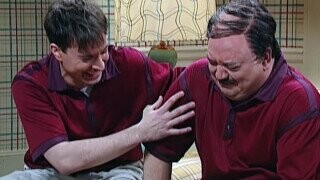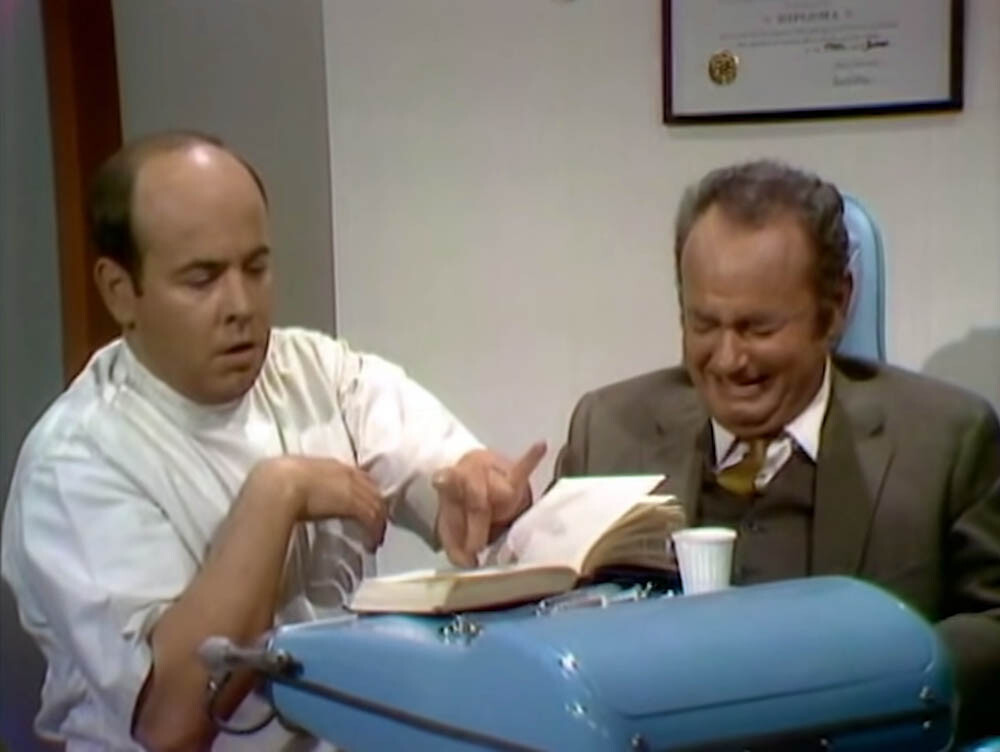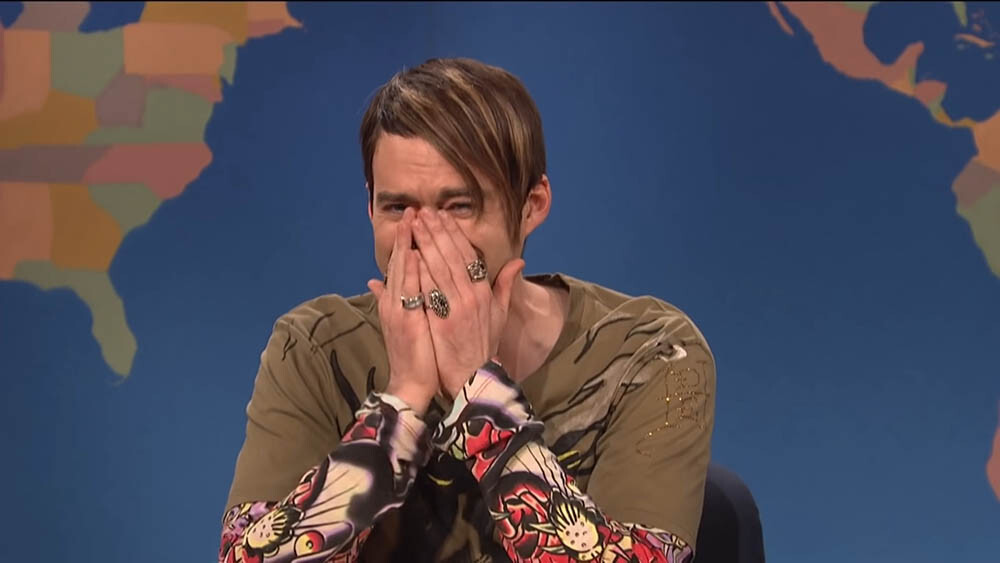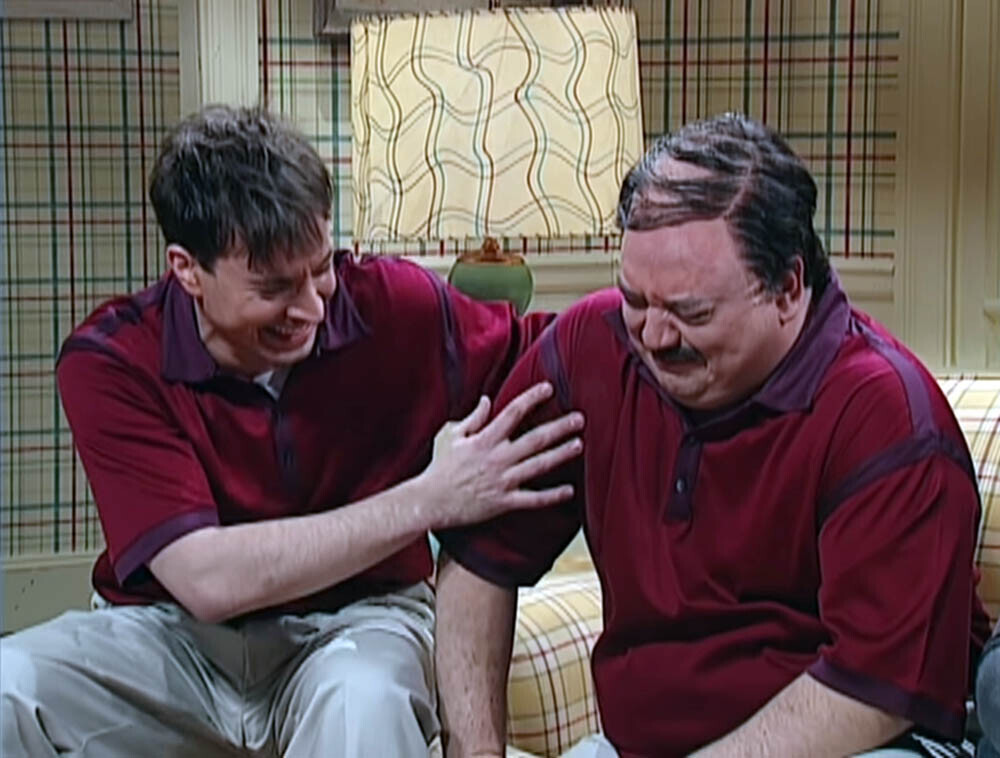When Comedians Crack Up: An Analysis

Welcome to ComedyNerd, Cracked's daily comedy superstore. For more ComedyNerd content, and ongoing coverage of the <break to begin laughing uncontrollably> Iran/Contra Affair, please sign up for the ComedyNerd newsletter below.
Don't Miss
Give Andy Samberg and Adam Sandler credit: They were honest about it. On Saturday Night Live’s 40th anniversary show, the two busted out a Lonely Island track about the comedy sin of “breaking” -- basically, cracking up during a sketch.
Sometimes, the song argues, you just can’t help it:
It's the night of the show, your sketch is killin'
The audience is having the time of their lives
When suddenly, it hits you: a case of the giggles
And you know you just can't hold it inside
And that's when you break
Sure, an attack of the chuckles. We’ve all been there. But the next verse gives away why people (especially comics!) really hate comics breaking character:
Sometimes a sketch just ain't workin'
You're giving it your all but it isn't enough
Your jokes are falling flat and your palms are all sweaty
But you know a trick to cover it up
And that's when you break
That’s the breaking conundrum. Cracking up at your own bit is a funny-faux-pas, a comedy no-no taught in every beginning improv class. Don’t laugh at your own jokes!
And yet? It works.
“No one likes when you break in the sketch,” notorious giggle boy Jimmy Fallon told Andy Cohen about how he was constantly angering Lorne Michaels. “All I can tell you is I was in a sketch with all of these funny people and I just couldn’t hold it. I was like ‘You’re ruining it, you idiot!’ But it’s funny.”
“That’s Carol Burnett”
Jimmy Fallon isn’t the only one who loses it during comedy sketches. He’s just the most obnoxious about it. The funnier the sketch comedy, the more likely you’ll see someone breaking character when the absurdity gets too much to bear.
The gang over at Whose Line Is It Anyway were always good for an unexpected snort or two, but we can cut them some slack for not knowing what insanity might spill out of a castmate’s mouth. The element of surprise is an effective weapon against deadpan.

ABC
We can’t give the same break to Monty Python. A live performance of its famous parrot sketch somehow got to Michael Palin, even though he and John Cleese had performed it dozens of times.

The Secret Policeman's Other Ball
The audience knew what parrot jokes were coming, which somehow amped up the laughs. At the first sign of Palin losing his composure, the crowd whipped into a frenzy of hilarity, making a straight face that much more difficult. Cleese, sensing blood in the water, raises his voice another octave to go in for the kill.
But the original King of the Crack-Up was indisputably The Carol Burnett Show’s Harvey Korman.

CBS Television
Castmate Tim Conway was genuinely hilarious, but Korman’s inability to make eye contact without peeing his pants became an annoying recurring bit that younger comedians disdained. Lorne Michaels reserved a disdainful place in his Lorne heart for Burnett’s show, according to Saturday Night: A Backstage History of Saturday Night Live. In fact, he held up Burnett as an example of everything he didn’t want early SNL to be.
He especially hated performers who broke up mid-sketch, the sheer, disgusting vanity of comics being uncontrollably amused with themselves. In the early days of SNL, such antics would be dismissed as “That’s Carol Burnett.”
(Cracking up is “Carol Burnett” and not SNL? See the Sandler/Samberg song and laugh at the irony.)
Burnett, for her part, wasn’t nuts about breaking either.
“Some people think we constantly cracked up during our eleven-year run, and it’s just not so,” Burnett wrote in her memoir, In Such Good Company. “Yes, we were guilty of breaking character at times, but not as often as you would think.”
But often enough for MeTV to put together a compilation reel of Carol Burnett Crack-Ups.
So, yeah, Carol, we're calling BS on that one. Her show didn’t have to include Korman squeezing tears from his eyes, contorting his crimson face to stifle a laugh. After all, they could have done another take of the scene. That’s what happens on most sitcoms when the actors lose it.
Cool or not, breaking is funny. That’s why there were blooper reels on DVDs back when DVDs were a thing. (Come on, Netflix and Hulu -- what’s stopping you from delivering some messed-up outtakes? It’s practically free content? But, we digress.)
The likeliest reason The Carol Burnett Show included those breaking moments was that the show filmed before a live audience. What good is it to shoot a second version with no breaking but half the laughs? No one would air the less funny version.
Which brings us to Saturday Night Live, the show that aspired to be the anti-Carol Burnett.
If it isn’t funny, then we have a problem
“I always loved when things went ‘wrong’ on the show because it reminds you the show really is live,” says Rachel Dratch in Live From New York: The Complete, Uncensored History of Saturday Night Live.
Dratch’s first Debbie Downer sketch either went incredibly “wrong” or incredibly “right,” depending on your comedy point of view. “Jimmy and Horatio were laughing really hard at rehearsal,” she says, “and I was thinking, “These guys, they better not mess up my thing with cracking up.”
They cracked up. Bad. Lindsay Lohan barely made it through the sketch, almost as if no one told her laughing was verboten. She’s even pounding the table in glee at one point. “It was just a random giggle fit that was completely contagious,” remembers Dratch.
“Horatio was wiping tears of laughter out of his eyes with a waffle,” says writer Paula Pell. “It was such an orgasmic experience for a comedy writer.”
And less pleasurable for a performer. “I try not to laugh too much, because I don’t like it when I’m watching TV and I see someone breaking up all the time; it becomes sort of cheap,” admits Dratch. “But sometimes you just can’t help it.”
Saturday Night Live generates the perfect storm for breaking character. There’s an audience to goose the laughter. The show is live, so you can’t start over when the unexpectedly ridiculous happens. And you have castmates that make it a personal challenge to provoke forbidden smiles.
“(Chris Farley) would try to break me up on the air,” says Chris Rock. “He broke Spade up a lot. You have to watch the sketches.”

NBC
“Jimmy’s the only guy who gets me to break,” confesses five-time host Justin Timberlake. ”I mean, there’s a certain thing that happens with him where it’s almost like the more he breaks the funnier the sketch gets. It’s a weird thing.”
Fallon and Horatio Sanz get a lot of grief for playing the breaking card. But based purely on the results, can you blame them? One thing that’s undeniable about sketches where cast members break: We remember them. The breaking sketches are the ones people share on social the next day.
Arguably the biggest breakout character of the last decade was Bill Hader’s Stefon, notorious for hiding his sniggers behind blousy Ed Hardy shirt sleeves. Was it a bit or genuine laughter? A combination of both?
“When we did the first one, Bill broke ridiculously,” remembers writer John Mulaney. "He completely fell apart, which is really funny to me because he felt really bad about breaking on-air. I was also very aware that people can have comedy purity issues with breaking on a live show, but I thought it was so funny and genuine that first time that he laughed, that I just always wanted to keep it funny and genuine by messing with him”.
So Mulaney got diabolical. He made it his mission to make Hader break, genuinely break, every time he reprised Stefon. The key was surprise: Hader rehearsed using one set of cue cards, then Mulaney inserted a few out-of-left-field gags before air. Hader read the new jokes for the first time on live television -- and inevitably, he lost it.
“The biggest one I think ever was when I put in a whole new joke,” says Mulaney. “Stefon asked Seth, 'You know Blacula, the black Dracula? Well, this one was the Jewish Dracula.' And Seth asked, 'What’s his name?' And Stefon says, 'Sidney Applebaum.'"
You can see Hader reading the joke in real-time just milliseconds before the words escape his lips. He’s destroyed, of course.

NBC
And he felt terrible. Despite the character’s success, Hader knew that breaking broke the rules. It was the cardinal sin. That’s Carol Burnett.
“I went to Lorne at an after-party once,” says Hader. “And I said, “I’m very sorry I keep breaking as Stefon. I’m a little nervous because I’ve broken every single time I’ve done it, so now I feel that the audience is waiting for me to break, and I feel a lot of guilt about this.”
Lorne’s response was a wise one, representing both an evolution in his thinking and an important distinction when it comes to breaking character. He looked Hader in the eye and said:
“Well, if what you’re saying isn’t funny, then we have a problem. But what you’re saying is so outrageous, everyone’s laughing. It’s when what you’re saying isn’t funny and you’re trying to save the sketch, or you’re trying to pull focus away from other performers, or pull focus away from the idea of the sketch and the writing and just trying to pull it all to you, then that’s when we have a problem.”
Makes sense. Now could someone explain the rules to these guys

Top Image: NBC
